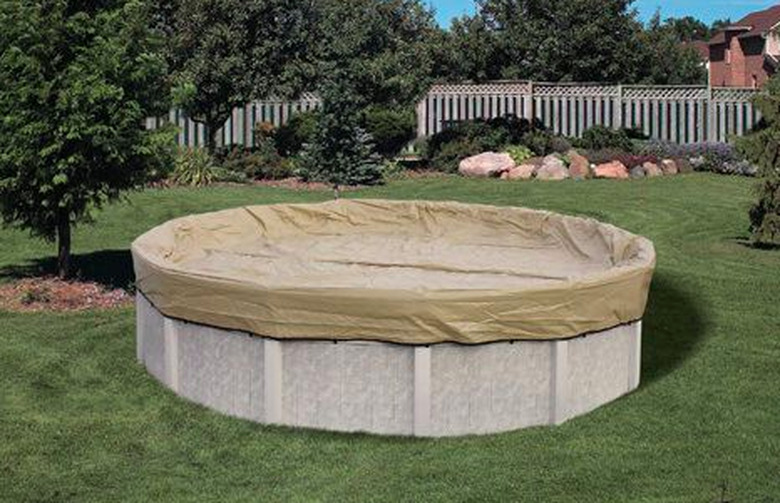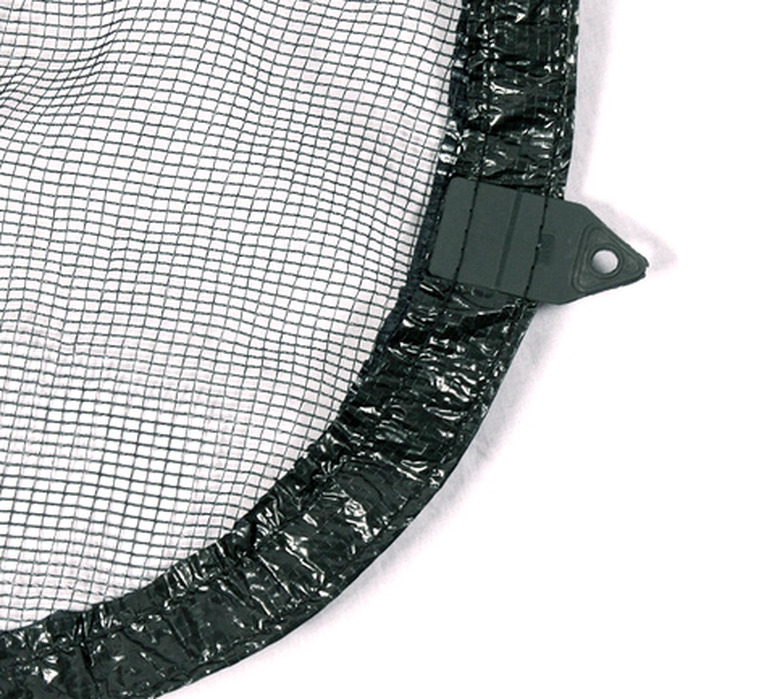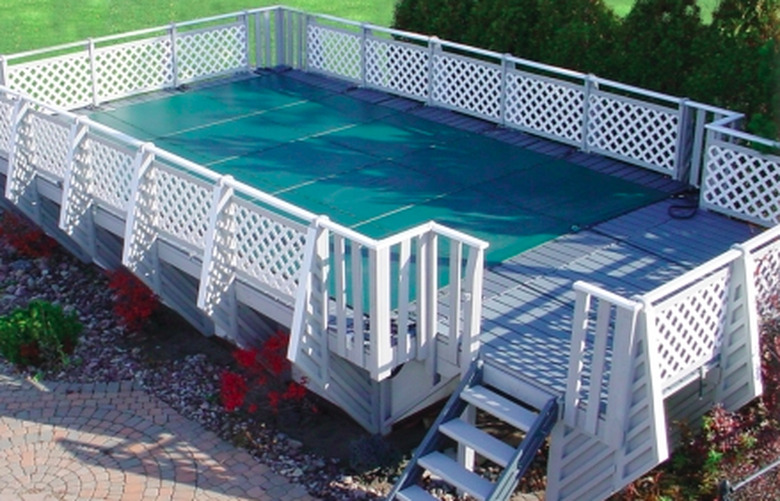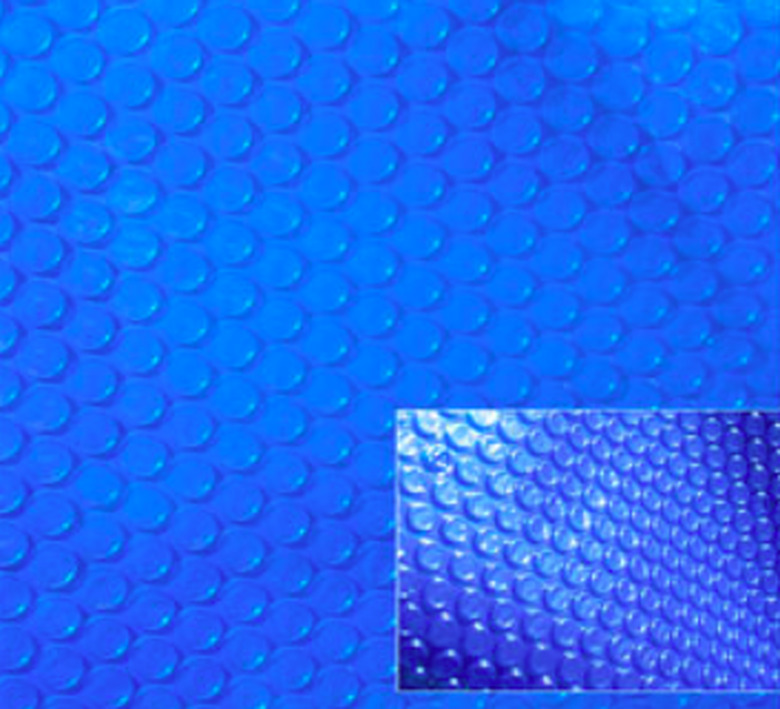Above-Ground Swimming Pool Cover Ideas
Your above-ground swimming pool will benefit from having a cover that you use regularly. During the swimming season, a cover will prevent leaves, insects and other debris from getting into your pool, reducing the vacuuming you need to do and relieving the load on the filter system. The right kind of cover can also reduce heat loss from your pool, making the water more comfortable and maybe even extending the swimming season by a few weeks at the beginning and end. A good swimming pool cover can also be a safety measure, preventing children and pets from getting into the pool when you're not watching.
Purchased Cover Options
Purchased Cover Options
A purchased cover designed for use with above-ground pools is your best option. These covers are available in a variety of shapes to match standard pool sizes, and they likely come with the accessories necessary to secure them. As you shop, you will likely notice that pool covers are offered in a range of quality options. Some things to look for:
- Look for heavier polyethylene fabrics, woven with tough mesh fibers. Covers made by laminating several layers will be more durable.
- Look for good grommets — the metal "eyes" by which the edges of the cover are held in place. Reinforced grommets that won't tear out will ensure long life for your cover.
- Check to see if attachment clips or weights are included. Some covers are secured with bungee cords or water weights that attach to the perimeter grommets — if these accessories are included with the cover, it means there will be less for you to buy.
Purchased pool covers come in several forms. Costs can range from $50 or $60 for basic debris-guard covers, to several hundred dollars for a good safety cover.
Here are some of the common types of purchased covers for above-ground pools.
Debris Covers
Debris Covers
This is a fairly basic type of cover, designed simply to catch leaves, twigs, insects and other debris before they can get into your pool water. This is the type of cover that's normally put on each day after swimming is over, then taken off each time the pool is used. It is the least expensive type of cover, and consists of a solid sheet of plastic tarp-like fabric interwoven with fiber mesh.
Although sometimes referred to as "plastic mesh," the material is actually a fairly tough grade of polyethylene, interwoven with tough strands of polyethylene fibers. Reinforced metal grommets around the edges offer the means of securing the cover in place, either by bungee cords and stakes driven into the ground or by weights or clips attached to the grommets.
Check with the manufacturer of your pool for recommendations. There may be a proprietary cover they offer that is designed for your pool; it may have clips or hardware for securing it to the frame of the pool.
The drawback of this kind of solid cover is that rainwater and debris can pool on top of the cover. It is also not intended as a safety cover — it will not hold the weight of pets or children climbing on top.
Mesh Covers
Mesh Covers
This variation of the basic debris cover has a porous fabric that allows water to drain through it, but with a tight enough weave that it will catch all leaves and debris. The advantage here is that you won't need to deal with a big puddle of water in the middle. This type is sometimes used as a winter cover left in place in the off-season.
Winter Covers
Winter Covers
Most covers sold as "winter" covers are an extra-tough form of the standard debris cover, but are often equipped with a system of perimeter cabling that allows the cover to be cinched down tight for a permanent seal over the long winter period. This is a fairly expensive cover, but one that will protect the inside of the pool very well. Some styles have tube weights that hang from the grommets to hold the cover down in place.
Safety Cover
Safety Cover
A so-called safety cover is not aimed at keeping dirt out at all, but consists of a very tough mesh the stretches drum-tight over the top of the pool and is sturdy enough to prevent pets or children from falling through. The edges are secured with an elaborate system of sturdy clips. Expect to pay several hundred dollars for a good safety cover.
Look for one that is certified by ASTM (American Society for Testing and Materials) if you are intent on your pool being genuinely child-proof.
Solar Cover
Solar Cover
A solar or "heat blanket" cover is made of fabric consisting of tough, bubble-like cells. It looks quite similar to a large sheet of bubble paper. These covers also serve as debris shields, but the cell structure provides insulation to keep heat from radiating out of the pool at night. The covers can also absorb heat from the sun, especially those made from clear poly.
These covers fall at the high end of the cost range. Thicker blankets are both more durable and offer better insulating value.
Additional Cover Options
Additional Cover Options
Although commercial covers are more effective, there are also other options for shielding your above-ground pool from debris.
Plywood Sheets
Plywood Sheets
Smaller above-ground swimming pools that have rigid steel walls can be covered with sheets of plywood. Although most plywood is sold in 8-foot-long sheets, 12-foot sheets may be available at some lumber centers. Secure them in place by drilling holes at the corners and anchoring them to the ground with bungee cords and tent stakes. Weighting the edges of the plywood with bricks or stones can also help keep them in place over the winter.
Use exterior "sheathing"-grade plywood for this application, such as the type used for roof decking on houses.
Tarps
Tarps
An ordinary tarp from the hardware store or home center can also make a cover for an above-ground pool, since many are made from the same polyethylene material used for commercial pool covers. However, unlike purchased covers, tarps are rectangular, so they pose some challenges to hold in place. Use bungee cords and tent stakes to secure the tarp at all four corners, and at all grommet locations along the straight edges of the tarp.
Because a tarp cover is not very tight, it is more prone to water puddling in the center. One solution is to build a framework of PVC piping as the support for the pool cover. This will raise the cover up slightly so it doesn't droop in the center. Water will then drain off the pool cover rather than creating a large messy puddle in the center.
This inexpensive option is not a "safety" cover in any way, as it will not support the weight of pets or children.
Plastic Sheeting
Plastic Sheeting
Although not a very effective option, ordinary "poly" sheeting can be used in a pinch to cover a pool. If you try this, use a very thick grade of plastic, as lighter grades will easily tear and blow away. The minimum grade you should use is 6 mil, and a heavier grade would be better if you can find it.
Sheet plastic is rather hard to hold in place over the pool, since there are no grommets. The best method is to clamp it around the frame members of the pool in many locations. This is by no means an option for covering a pool over the winter, but may help protect the pool from an autumn leaf-drop expected to last only a few days.



